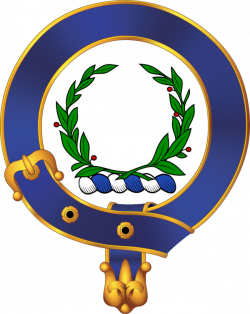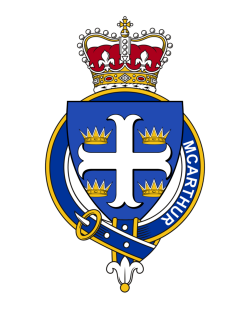
Clan Arthur
FAITH AND WORK
Clan MacArthur are one of the most ancient Highland clans. An old proverb used by Western Highlanders was "There is nothing older, unless the hills, MacArthur, and the devil".
The MacArthurs and the Campbells shared a common origin, and at one point the MacArthurs were a threat to the seniority of the leading Campbell family. The MacArthurs were hereditary pipers for MacDonald of the Isles, and in 2002 the first clan chief for over 230 years was officially recognised.
The MacArthur clan motto is "Fide et opera" (By fidelity and work) and the clan crest is two laurel branches.
The Tartans
of Clan Arthur
Scottish History
of Clan Arthur
The rise and fall of the MacArthurs
There are many who believe that the Clan MacArthur is descended from the legendary King Arthur of Round Table fame. Certainly there are several historical arguments which support the notion that Arthur was, if not Scottish, based in Scotland during the sixth century.
Arthur’s Seat, an extinct volcano, is in Edinburgh’s Old Town. Camelot could have been built there as it is a fine spot for a royal court with uninterrupted views in directions. Merlin’s grave is thought to be in a field near the village of Drumelzier close to the River Tweed. Thomas the Rhymer is said to have written the following prophecy: When Tweed and Powsail meet at Merlin’s grave, Scotland and England, shall one Monarch have.
This came true in 1603, when the river Tweed overflowed its banks and met the river Powsail at the site of Merlin’s Grave – on the very same day that the crowns of Scotland and England were first united under James VI of Scotland who became James I of England. Thomas the Rhymer was a thirteenth century seer, who prophesied in rhyme and was originally known as Thomas of Ercildoune, named after a town in Berwickshire now known as Earlstoun. Thomas is said to have predicted several significant events in Scotland’s history including the succession of Robert the Bruce to the throne and the defeat at Flodden. King Arthur died at the Battle of Camlann and that site is thought to be modern-day Camelon near Falkirk.
Some historians believe that the Clan Campbell and Clan Arthur (which later became MacArthur) are both descended from him. However, the first time both families appear in historical records is during the reign (1249-86) of King Alexander III. Their chiefs were MacArthur and MacCailean Mor. The latter, after whom the Campbells are named, was thought to be the Sheriff of Argyll in the middle of the thirteenth century. Yet, at that time, his kinsmen were not among the landowners of Argyll. Instead, it was the MacArthurs who controlled large estates and were more powerful. And they were to expand their influence still further in the days of Robert the Bruce. After helping him to victory at Bannockburn in 1314, they were rewarded with even more land, taken from the MacDougalls, who had opposed The Bruce. The Clan chief was made Keeper of Dunstaffnage Castle and was handed large parts of the Lorne. The castle, near Oban, had been a MacDougall stronghold until 1309. MacArthur’s descendants then extended their control to Strachur on the shores of Loch Fyne along with bits of Glenfalloch and Glendochart, both in Pethshire. This was the best time to be a MacArthur, with the clan at the height of its wealth, power and influence.
But two unconnected events combined to lead to their demise and the ascent of the Clan Campbell. The first was the marriage of Sir Neil Campbell to Robert the Bruce’s sister. There is no question that the Campbells benefited beyond their wildest dreams by marrying into the royal family. Before long they became major landowners and set their sights on the chieftainship of the combined MacArthur-Campbell clan. This was blocked by MacArthur who received a royal charter stating that his lands could only be taken from him by the king. The second major upheaval in the MacArthur fortunes came during the reign of King James I of Scotland (1406-1437). James, who had been born in 1394, had been held prisoner by King Henry IV of England for 18 years, but was freed at the age of 30 and returned home to claim his crown. At that time Scotland was split into lawless factions and James had to take drastic action to regain control. He targeted the clans of the north and west, where allegiance to the crown was transitory. In 1427 he invited many Highland chieftains, including John MacArthur, to a parliament meeting in Inverness. MacArthur was among those the king mistrusted and he was imprisoned and beheaded. His lands were taken from him and from then on the Clan ceased to be a major force in Scotland. The Campbells, meanwhile, continued to grow from strength to strength and eventually were elevated to the Scottish nobility. The MacArthurs held on to some of their land – near Strachur and in bits of Perthshire. And at Dunstaffnage Castle, where they were hereditary keepers, they became tenants of the Campbells.
However, while the ancient MacArthurs suffered a spectacular fall from grace, their more modern descendants certainly did more than their fair share to bring the Clan name back to the fore.
Controversy and conflict
Douglas MacArthur led a highly controversial life. He became one of America’s most famous generals and was responsible for the re-building of Japan after World War Two, but was dismissed from his command at the height of his powers.
He was the grandson of Arthur MacArthur Sr, who was born in Glasgow in 1815, but was taken to the USA as a a teenager when his mother re-married after his father’s death. Arthur studied law briefly at college but dropped out to get a job in support of his family during a major depression in 1837. He worked his way up from a legal clerk, first in Boston, then New York and entered the New York bar in 1841. Three years later he married Aurelia Belcher, whose father, a rich industrialist, helped MacArthur establish a lucrative legal practice In Springfield, Massachusetts. However, the relationship between him and his in-laws was strained due to differences in their political beliefs and so MacArthur moved from the east coast to Milwaukee, Wisconsin in 1849. There he quickly gained the friendship and respect of the movers and shakers. Two years later he was elected to the post of City Attorney and in 1855 he accepted the Democratic nomination for lieutenant governor to William A Barstow, who was running for re-election. The election ended in uproar amid accusations of vote rigging. Barstow and MacArthur had won by just 157 votes. Their opponent, Coles Bashford, challenged the result alleging fraud and after an investigation his claim that voting papers were forged was substantiated. Barstow and MacArthur decided to tough it out and were inaugurated on January 7, 1856. But less than three months later, realising the game was up, Barstow resigned. MacArthur became acting governor and despite a rising tide of public opinion against him, and the threat of legal action, he decided to remain in office. However, four days later, he too moved out in favour of Bashford. MacArthur emerged almost unscathed from the episode and was even allowed to remain as lieutenant governor for another year. Indeed, his political career locally and nationally continued smoothly and he was elected twice as a judge in Wisconsin between 1857 and 1869. A year later President Ulysses S Grant appointed him a judge on the Supreme Court of Washington DC, a post he held for 17 years until his retirement. He spent the remainder of his life socialising with the great and good of the nation’s capital and became a noted speaker and author, dying in 1896 at the age of 81.
He had two sons. One, Arthur MacArthur Jr, who was born in 1845, became a distinguished general. MacArthur junior studied at the US Military Academy at West Point and when the American Civil War broke out in 1861 he signed up with the 24th Wisconsin Volunteer Infantry. Despite his youth he was a born leader and a brave soldier. His exploits earned him the Medal of Honor, the highest military decoration awarded by the United States. In 1865 he decided to follow his father’s footsteps and study law, but it was not for him and within a few months he was back in the army, as a junior officer. For the next 30 years he was posted across the USA, including Little Rock, Arkansas, where Douglas MacArthur was born in 1880. In 1885 Arthur and his family found themselves in New Mexico, where he was involved in the final victory against Geronimo, the famed Apache military leader. MacArthur’s first major military action since the Civil War came in the final battle of the Spanish American War, which ended with the USA taking control of former Spanish colonies Guam, The Philippines and Puerto Rico. By now he was a brigadier general and took part in the Battle of Manila. After the Spanish surrender, in August 1898, the Filipinos launched a war of independence against their American occupiers and MacArthur remained there, eventually becoming military governor.
By now his son Douglas was about to begin his own illustrious military career, which would see him join his father in the Philippines.
Family History Mini Book
We hope you enjoyed reading this excerpt from this mini book on the Scottish history of the Arthur family.
You can buy the full book for only111 Clan Arthur
Tartan Products
The Crests
of Clan Arthur























































